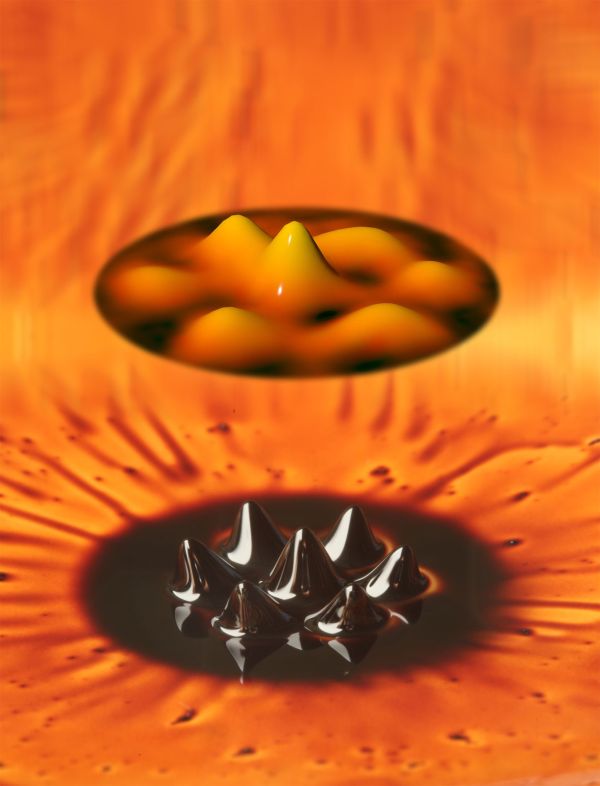Scientists create new state of matter: Quantum gas, liquid and crystal all-in-one

Schattenrissaufnahme des Quanten-Ferrofluids im Experiment. Die kristallartige Anordnung der Tröpfchen ähnelt deutlich den regelmäßigen Spitzen im klassischen Ferrofluid (unten), die sich ausbilden, wenn ein Magnetfeld angelegt wird. Abb. Universität Stuttgart
The world of quantum mechanics happens only in small scales around a few nanometers. In this nanoworld, particles can behave like waves, and vice versa and have only some probability to be in a particular region. These effects can be directly observed in ultracold dilute gases.
For this purpose thousands or a million atoms are cooled down to a few billionth of a degree above absolute zero. At such low temperatures particles become indistinguishable und unite collecitvely to a single giant matter wavecalled Bose-Einstein condensate which has astonishing properties. The matter wave flows as quantum fluid practically without inner friction, thus it is namedsuperfluid.
Researchers around Tilman Pfau at the Center for Integrated Quantum Science and Technology IQSTin Stuttgart (Germany) created such a quantum fluid made of tiny magnets – that areatoms of the most magnetic element dysprosium. They call it “quantum ferrofluid” since it is superfluid and has magnetic properties similar to classical ferrofluids.
Ferrofluids consist of ferromagnetic nanoparticles dissolved in oil or water. When a strong magnetic field is applied perpendicular to the surface of the ferrofluid it undergoes a so-called Rosensweig instability. The surface is no longer smooth like normal fluids, but it generates a regular thorny surface resembling a hedgehog.
From the point view of the tiny magnets in a ferrofluid, every south- and northpole attract each other. Therefore, it is energetically favourable to be on top of each other along the field direction, so the fluid grows peaks out of the smooth surface.
For their investigations, described in the science journal “Nature”, the researchers from Stuttgart created a quantum ferrofluid with 15,000 atoms and induced a magnetic instability. They observedthen the emergence of regular patterns consisting ofmicroscopic droplets, similar to the Rosensweig instability of ferrofluids.
Each droplet has a radius smaller than 1 µmand theirexistence was not expected with the current state of research on these systems.Their observation could thus lead to a new field of research, as the researchers expect quantum fluctuations, related to Heisenberg’s uncertainty principle,to play an important role in the droplet existence.These quantum fluctuations allow a unique state of matter that connects opposite properties of gases, crystals and superfluids. This connectioncould be the path to a so-called supersolid, a spatially ordered material with superfluid properties.
Kontakt: Prof. Dr. Tilman Pfau, Universität Stuttgart, 5. Physikalisches Institut, Tel. 0711/685-68025, E-Mail: t.pfau (at) physik.uni-stuttgart.de
Media Contact
More Information:
http://www.uni-stuttgart.de/All latest news from the category: Physics and Astronomy
This area deals with the fundamental laws and building blocks of nature and how they interact, the properties and the behavior of matter, and research into space and time and their structures.
innovations-report provides in-depth reports and articles on subjects such as astrophysics, laser technologies, nuclear, quantum, particle and solid-state physics, nanotechnologies, planetary research and findings (Mars, Venus) and developments related to the Hubble Telescope.
Newest articles

Properties of new materials for microchips
… can now be measured well. Reseachers of Delft University of Technology demonstrated measuring performance properties of ultrathin silicon membranes. Making ever smaller and more powerful chips requires new ultrathin…

Floating solar’s potential
… to support sustainable development by addressing climate, water, and energy goals holistically. A new study published this week in Nature Energy raises the potential for floating solar photovoltaics (FPV)…

Skyrmions move at record speeds
… a step towards the computing of the future. An international research team led by scientists from the CNRS1 has discovered that the magnetic nanobubbles2 known as skyrmions can be…





















